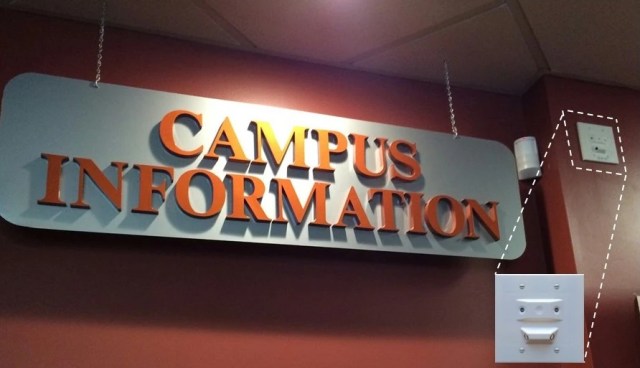FEATURE ARTICLE: Reducing Response Time
Reduce response time to active shooter incidents on campus with gunshot detection
If you are a member of campus police or a student on campus and you are in Building C and an active shooter starts firing in Building A, how do you know? When do you know? Who notifies 911 and how long does it take? How does that information get to you? Just as important, is it accurate?
In reaction to the Virginia Tech shooting in 2007, where an active shooter managed to go undetected for two and a half hours after his first two shots were fired in a dormitory and later shot 47 people he locked inside an academic hall, colleges and universities began implementing more robust mass notification systems. Emergency kiosks, panic buttons, and “blue light boxes” became more widely deployed. These types of systems have greatly improved emergency communications on campuses, however they still require some form of human element to set them off, such as a student who presses the panic button or a security dispatcher who must compose and send the mass notification message.
While 911 and mass notification systems remain viable, well established solutions for campuses, the addition of gunshot detection can supplement these systems by filling in critical missing gaps and improving the flow of information during an active shooter incident. The premise behind gunshot detection is that it will alert campus police faster than any current method. Providing vital location information, including where in the building the incident is happening, cuts through typical alert delays so more immediate response is initiated. To be most effective, the gunshot detection system will alert before the first 911 call and integrate with mass notification, video, public address systems and other alarms. The real power in gunshot detection is leveraging integration that automates alerts to multiple parties simultaneously, including campus security, students, staff and visitors, so appropriate response actions can be immediately initiated.
The Active Shooter Threat
In the 1990’s and 2000’s the U.S. witnessed a rising and disturbing trend of mass shooting incidents happening in schools, workplaces, movie theaters and other everyday environments. This created an influx of active shooter solutions to the market including ballistic glass, door locks and panic buttons. While they might be useful, these solutions still do not address the lack of critical information flow as a shooting incident unfolds – the what, when, how and where questions still need to be answered. To address these problems, Shooter Detection Systems began adapting a military gunshot detection system, known as Boomerang, for indoor environments and brought these systems to the commercial market in 2014. Today, gunshot detection technology is being used by higher education organizations including Georgia Tech, Savannah College of Art and Design and others, as well as on corporate, K-12 and government campuses.
Indoor Gunshot Detection Systems
In the process of educating yourself on what gunshot detection system is right for your campus, it is easy to get lost in technical and marketing jargon along the way. Before you get too far down the rabbit hole, remember the key questions: How do you know it is a gunshot? How is the information getting to you and others on campus? How long does that take? Is the information accurate?
At their core, all indoor gunshot detection systems are comprised of one or more sensors strategically positioned within facilities that transmit gunshot alerts through a communications platform. When evaluating sensor types, it is important to ask if the sensor will alert automatically or if it requires any machine learning or external validation. In other words, where is the shot processing taking place and how quickly does that happen? If the sensor does alert automatically, how does it filter out false alerts? If the sensor requires some kind of external or database verification, how long does that process take? How reliable is it? Asking these questions will help you understand the system’s rate of detection, detection accuracy, speed of alerting, and how the sensor accomplishes these tasks.
Systems that rely on acoustics only can potentially produce false alerts due to loud noises in the environment. Systems that use AI or machine-learning are reliant on event comparison to a database or library of sounds in an attempt to filter out shot events from other sounds in the environment. Some systems send audio files to human analysts at a monitoring station to verify “possible” shot events or stream audio to the cloud. Audio clips sent outside of a local server may open organizations up to privacy concerns or violate privacy laws in hospitals and other settings. Sensors that require manual calibration can be problematic in that they require close monitoring and analysis for a time before they are fine-tuned to sounds in the environment. Sensors that rely on any type of external validation will have delays in alerting speed and run the risk of producing false alerts.

Dual-mode or multi-mode sensors utilize acoustic detection plus additional detection technologies onboard the sensor. Shot information is generally processed at the sensor level, which requires no extra steps for the system to determine that a shot event has occurred. Dig deeper into these systems by asking what those additional modes are, and what conditions need to be met in order for the sensor to alert. Sensors that require both the signature of a gunshot (acoustic sensor) and the flash of a weapon (infrared sensor) to validate a shot will be most accurate in filtering out false alerts.
There is also power and networking to consider. Power-over-Ethernet (PoE) has advantages but has an impact on infrastructure, and DC power requirements could be problematic and subject to tampering. Wireless systems are the most flexible to install, however, end users should ask about sensor uptime and self-testing features and how they impact battery life, and if the communications system is secured with encryption.
Benefits and Best Practices
To put the benefit of reducing response time with gunshot detection into perspective, the average length of an active shooter incident is around five minutes, with an average of one death occurring every 5 to 15 seconds while active shooting is taking place. Ultimately, you need to be able to rely on your gunshot detection system to automate the alerting process as early as possible and from the incident occurring with the highest level of accuracy in order to justify the investment. Think back to the Virginia Tech shooting. After the dormitory shooting, the perpetrator fled the building undetected and returned hours later to complete his mission. Thirty-two people lost their lives when it was finally over. If gunshot detection technology were in place to detect the initial shot, the response may have been drastically different. Think how many lives could have been saved.

For all the benefits gunshot detection can bring to a campus environment, the difficulty with system selection is that at this time there is no one governing body that regulates the industry or monitors marketing claims. An important resource any campus operator should look for is the U.S. Department of Homeland Security’s SAFETY Act program. Seek technologies that have been SAFETY Act Certified and bear the red Department of Homeland Security (DHS) seal of approval. This indicates that the technology is listed on the DHS Approved Products List for Homeland Security and has been vetted by the DHS Science and Technology Directorate (S&T), a DHS arm that monitors emerging threats and encourages private industry to create technology solutions to abate them. On the other hand, a product bearing a green or blue mark will have only a Developmental Testing and Evaluation Designation (DT&E), indicating that the technology is still in the development and testing phase. Additional best practices include involving your security integrator early in the process and asking the manufacturer for customer references.
Gunshot detection becomes the starting point of response by immediately bringing situational awareness to the forefront, providing clarity over confusion. Gunshot detection will improve your overall security posture and strengthen your response to active shooter incidents and could potentially boost recruitment efforts for parents and students that place a high value on campus security in the selection process. Focus on finding a system that uses multiple modes of detection, has a high rate of detection accuracy, fast alerting speed, flexible integration capabilities, and devices that use secure communications and are safe to use on your network.
Equally important is a system that can be integrated seamlessly with your existing video and emergency notification systems, and one that enhances your active shooter training. This is where true automation happens and where gunshot detection can have the most impact on reducing the loss of life during active shooter incidents.


Comment section